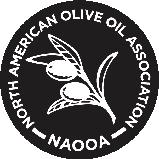FARM TO GLASS BEVERAGES
MODERN MEDITERRANEAN
CREATING RESILIENT STAFF
2BHOSPITALITY’S RISE


FARM TO GLASS BEVERAGES
MODERN MEDITERRANEAN
CREATING RESILIENT STAFF
2BHOSPITALITY’S RISE

PAUL & GWEN MANGIAMELE ARE BRINGING BACK STEAK AND ALE, PLUS MAKING OTHER BIG MOVES

SCALABLE CONCEPTS WITH SOUL IRON CHEF CHAMP JUSTIN SUTHERLAND IS SHIFTING HIS FOCUS AFTER A LIFE-ALTERING EXPERIENCE


Portable: Ideal for QSRs and customers on the go.
All-day appeal: Popular for breakfast, lunch, dinner and late night.

No additional training or equipment required.
June 2024 No. 126

FOUNDED IN 1966, STEAK AND ALE WAS WIDELY CONSIDERED THE EARLY MODEL FOR CASUAL DINING, AND WAS ALSO KNOWN FOR INTRODUCING THE SALAD BAR.
After nearly two decades, the iconic Steak and Ale brand is being resurrected by Paul and Gwen Mangiamele. The couple is on a mission to revolutionize casual dining by reintroducing legacy restaurants—including the other Norman Brinker-founded brand, Bennigan’s—and transform the concepts with modern touches.
After a life-altering experience, “Iron Chef” champ Justin Sutherland is shifting his focus to growing his two restaurants, Northern Soul and Big E.

All-day diner Radio Star is taking a fresh approach to regional flavors. Radio Star is a mix between a classic 1940s American diner and an Italian trattoria, with a focus on Mediterranean food and hospitality that ties back to the technological namesake.
Restaurants are finding ways to reduce beverage program costs with creative methods, like crossutilizing produce in the kitchen and the bar, and sourcing from local wineries and breweries.


Backed by celebrity chefs
Janine Booth and Jeff McInnis, Stadium Club is combining the best of high-tech sports bars, night clubs, and chef-driven restaurants inside Caribe Royale Orlando. Now, it’s gearing up for growth.
Coffee was the best-performing beverage sub-category at full-service restaurants in 2023, beating out other favorites like tea and soda, according to a recent Circana study. BACK OF HOUSE
ON THE RISE 2BHospitality is transforming fine dining with its two concepts: the Tuscany-inspired BellaBrava: New World Trattoria; and Stillwaters Tavern, a modern take on classic American scratch tavern fare.
YOUR TAKE Employee retention isn’t just about keeping warm bodies in seats; it’s about nurturing talent, fostering growth, and cultivating a sense of belonging.
BEHIND THE SCENES Discover why Joe Gillie chose to swap out his cozy corporate role as VP of operations at the better-breakfast brand, Famous Toastery, to become a franchise owner and live in the Blue Ridge Mountains. ALSO IN THIS
4 Editor’s Welcome 39 Advertising Index
EDITORIAL
EDITORIAL DIRECTOR
Danny Klein dklein@wtwhmedia.com
FSR EDITOR Callie Evergreen cevergreen@wtwhmedia.com
QSR EDITOR Ben Coley bcoley@wtwhmedia.com
ASSOCIATE EDITOR Sam Danley sdanley@wtwhmedia.com
VP EDITORIAL: FOOD, RETAIL, & HOSPITALITY
Greg Sanders gsanders@wtwhmedia.com
CONTENT STUDIO
VICE PRESIDENT, CONTENT STUDIO
Peggy Carouthers pcarouthers@wtwhmedia.com
WRITER, CONTENT STUDIO Ya’el McLoud ymcloud@wtwhmedia.com
WRITER, CONTENT STUDIO Olivia Schuster oschuster@wtwhmedia.com
DESIGN
ART DIRECTOR Erica Naftolowitz enaftolowitz@wtwhmedia.com
LinkedIn.com/company/ FSR-magazine Instagram.com/FSRmagazine Facebook.com/FSRmag Twitter.com/FSRmag

COVER (PHOTO), BEST USE OF COLOR NATIONAL SILVER AWARD: BEST USE OF TYPOGRAPHY
SALES & BUSINESS DEVELOPMENT
VP SALES: FOOD, RETAIL, & HOSPITALITY
Lindsay Buck lbuck@wtwhmedia.com
VP, BUSINESS DEVELOPMENT Eugene Drezner 919-945-0705 edrezner@wtwhmedia.com
NATIONAL SALES MANAGER Amber Dobsovic 919-945-0712 adobsovic@wtwhmedia.com
NATIONAL SALES MANAGER John Krueger 919-945-0728 jkrueger@wtwhmedia.com
NATIONAL SALES MANAGER Edward Richards 919-945-0714 erichards@wtwhmedia.com
CUSTOMER SERVICE REPRESENTATIVE Tracy Doubts 919-945-0704 tdoubts@wtwhmedia.com
ADMINISTRATION
919-945-0704 www.fsrmagazine.com/subscribe
FSR is provided without charge upon request to individuals residing in the U.S. who meet subscription criteria as set forth by the publisher.
REPRINTS
THE YGS GROUP
800-290-5460 fax: 717-825-2150 fsrmagazine@theygsgroup.com
Sponsored content in this magazine is provided to the represented company for a fee. Such content is written to be informational and nonpromotional. Comments welcomed at sponsoredcontent@ fsrmagazine.com.
FOUNDER
Webb C. Howell
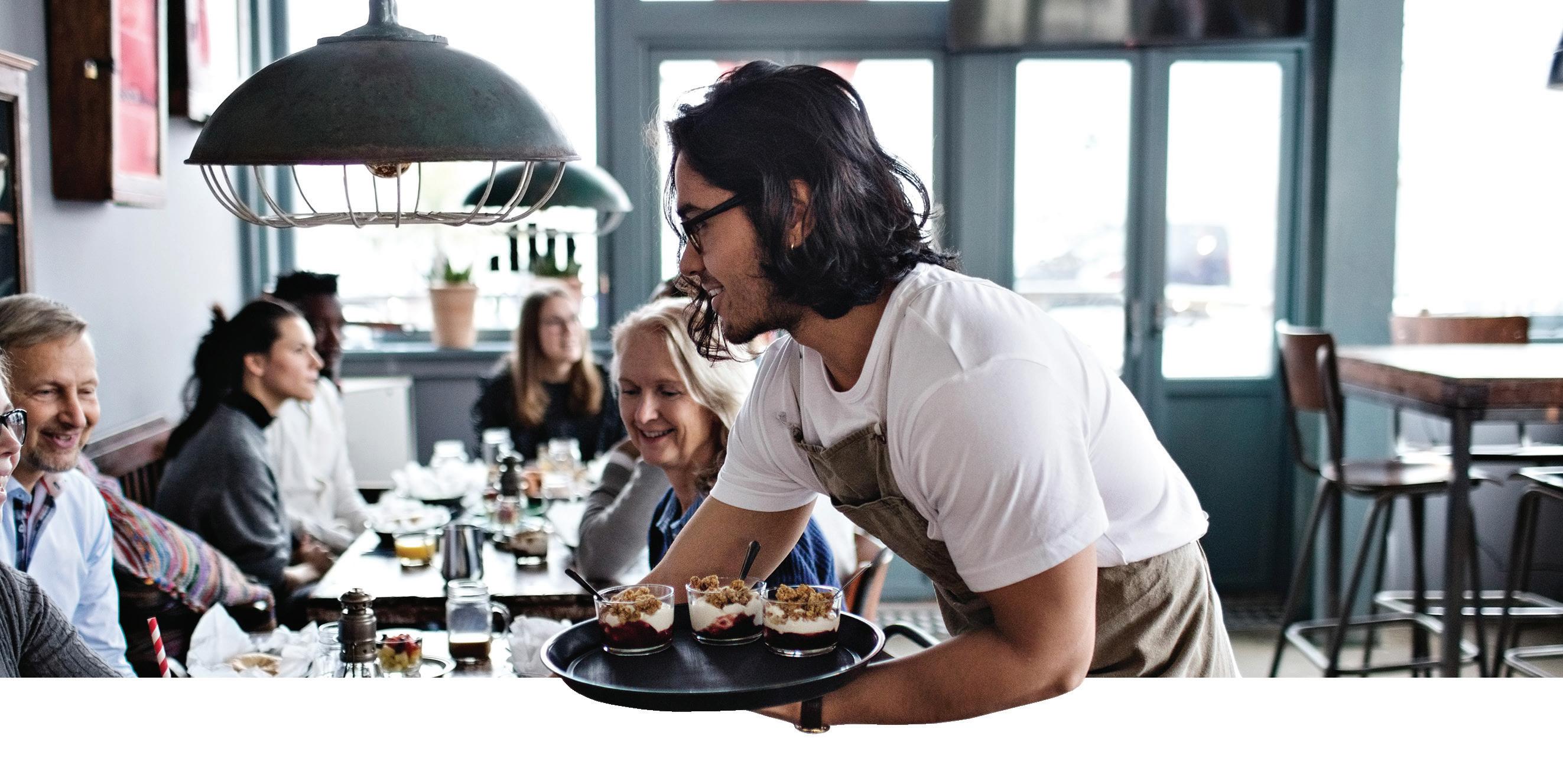
When you welcome American Express® Cards, you have access to benefits, services and programs to help your business, including:
•Curated offers & discounts to help you get more out of your business.
•Solutions & tips to help attract new customers.
•Free signage and supplies to show your customers which credit cards brands you accept
2.9X HIGHER SPEND 99% CARD ACCEPTANCE
In 2023, annual spend of American Express Card Members was, on average, 2.9x that of nonCard Members. 2 American Express can be accepted at 99% of places in the US that accept credit cards. 1
1. Based on the Feb 2023 Nilson Report.
60% HIGHER TRANSACTION SIZE
In 2023, the average transaction size of American Express Card Members was 60% higher than that of non-Card Members. 3

Scan the QR code for more information on resources for your business.
2. Nilson Report #1,257, February 2024. Spend per card derived from U.S. year-end purchase volume divided by year-end cards in force (CIF), not from individual consumer-level data. CIF represents the number of cards issued and outstanding with cardholders. Average Non-American Express spend per card includes Visa, MasterCard and Discover credit and charge card volume and CIF and excludes debit and prepaid volume and CIF.
3. Nilson Report #1,257, February 2024. Transaction Size derived from U.S. year-end purchase volume divided by year-end purchase transactions, not from individual consumer-level data. Average Non-American Express transaction size includes Visa, MasterCard and Discover credit and charge cards and excludes debit and prepaid volume and transactions.
IN LATE APRIL, I flew to Boston for a press trip to check out COJE Management Group’s restaurant concepts. My Uber driver and I were chatting, and his recommendations for the best food and drinks in town—the places where he and his friends frequented—were Lolita Fort Point, Yvonne’s, and Mariel. All COJE brands. He had no idea I was there to visit those concepts. It felt like he was a plant from the restaurant group, but they assured me he wasn’t. It goes to show how COJE’s team is doing something right if native Bostonians are suggesting their restaurants to tourists. The lesson here is that it all comes down to creating unique dining experiences and serving high quality food and beverages that people rave about.
Often, it can be helpful to look back and see what worked well in the past, but it’s a balancing act; you can’t get so caught up in nostalgia that you forget about the changing preferences of modern diners. That’s why Paul Mangiamele coined the phrase “NEW-stalgia” to describe the resurrection of Norman Brinker’s concepts, Bennigan’s and Steak and Ale (PAGE 26). “We’re going back to the speakeasy drinks, the traditional drinks. We’re introducing old-school back into the lexicon of our industry,” says Mangiamele, while simultaneously making upgrades and refining every aspect of the brands—from food recipes and beverage menus to the tech, furniture, fixtures, kitchen equipment, and everything in between.
The blending of the old with the new is, as “Beauty and the Beast” put it, a tale as old as time. On PAGE 16, read about the brand that’s mixing modern Mediterranean with nostalgia for audio tech: Radio Star, which opened its doors in Brooklyn, New York last year, is a restaurant, bar, and cafe inspired by the radio era of the 1940s, with all fixtures and furniture original from that time period. Elsewhere across our June issue, you’ll find other examples of innovation in the industry, like the high-tech, celebrity chef-backed sports bar of the future on PAGE 7, and creative beverage teams that are utilizing kitchen scraps for cocktails to reduce waste and program costs on PAGE 21. For 2BHospitality, collaboration with local artisans, farmers, and foragers is the name of the game for its two fine-dining concepts, BellaBrava and Stillwaters Tavern, in the fast-growing region of Tampa Bay, Florida (PAGE 35). And discover how finding balance in life for Joe Gillie meant giving up his corporate gig to become a franchise owner and live in the Blue Ridge Mountains (PAGE 40). So turn the page, and let’s dive in.
 Callie Evergreen EDITOR
Callie Evergreen EDITOR

cevergreen@wtwhmedia.com FSRmag @FSRmagazine

Also in this issue
Following a near-death experience after a freak boating accident, chef Justin Sutherland is refocusing his priorities on growing his original restaurant concepts Northern Soul—a Southern-style eatery with two locations in Minnesota that’s designed to fit into various venues—and his gourmet egg sandwich shop Big E, which has locations in Portland, Oregon, and in St. Paul, Minnesota. Sutherland, an “Iron Chef” champ and Emmy-winning host of “Taste the Culture,” also has additional TV projects in the works and another cookbook on the way.














Stadium Club is combining the best of high-tech sports bars, night clubs, and chefdriven restaurants.
OVER $140 MILLION has been injected into reimagining and transforming Caribe Royale Orlando, and the crowning jewel of the resort is Stadium Club—a hightech NextGen Casual concept that's poised for future growth in and outside of the hotel space. "I recognized we
needed a hangout spot. We needed a place with energy that would keep our customers and bring in locals that's got energy at night," says Amaury Piedra on a recent episode of FSR’s podcast, “The Restaurant Innovator.” Piedra, who started in the hotel business when he
was 15 years old, is managing director at Caribe Royale Orlando.
"It's like a sports bar on steroids, because it's got a very interactive component with the simulators. We wanted to make it an immersive experience that made you feel like you were at a game," he adds.
To create Stadium Club, Piedra partnered with celebrity chefs Janine Booth and Jeff McInnis, the husband-andwife team responsible for Root & Bone in Miami and Indianapolis. Booth and McInnis developed the menu, which is comprised of fun and elevated sports bar classics with twists. One option on the "Pre-Game" menu is Winning Mac Carpaccio with thinly sliced wagyu beef, shredded lettuce, and Stadium Club sauce. "The ordinary sports bar you go in doesn't have carpaccio made out of wagyu beef," McInnis says.
Entertainment is ingrained in every part of the guest experience, from the state-of-the-art sports simulator suites featuring 13 sports and games (from soccer to zombie dodgeball) to the unique presentation of the cedar plank salmon with bright green rice and marcona almond romesco. "We take a really high-alcohol, high-proof rum and pour it over the salmon and light it on fire tableside," Booth says. "So there's theatrics in the food and that creates another level, another layer of entertainment."
Looking into the future, franchising is on the table. Stadium Club has been receiving requests from across the country already, Piedra says, though he's not in a rush to expand too quickly. "We want to make sure we got everything where we want it to be, and then take a look at what the future holds."
Booth and McInnis will be refining the Stadium Club brand in the next few months. "We would love to see Stadium Club in all the major and minor cities around the country, so that's what we're going to be focusing on in the next few months," Booth adds.
TO LEARN MORE, CHECK OUT ‘THE RESTAURANT INNOVATOR’ ON ALL PODCAST PLATFORMS.

THE DAILY GRIND STILL INCLUDES A COMFORTING CUP OF CAFFEINE at full-service restaurants. Coffee was the best-performing beverage sub-category in 2023, beating out other favorites like tea, soda, and alcohol, according to a study by Circana and CREST. Another longterm trend highlighted was the opportunity that cold coffee presents. Iced/frozen coffee only makes up 12 percent of coffee servings at full-service establishments, well below the 35 percent share it has for total commercial foodservice servings in the U.S.
• Coffee servings, at over $36 billion, witnessed growth of 5% across nations, with 11 of the 12 monitored countries forecasted to grow.
• Coffee outpaced both tea (+4%) and carbonated soft drinks (+3%) in terms of year-over-year servings growth, emphasizing its position as one of the fastest-growing beverage categories globally.

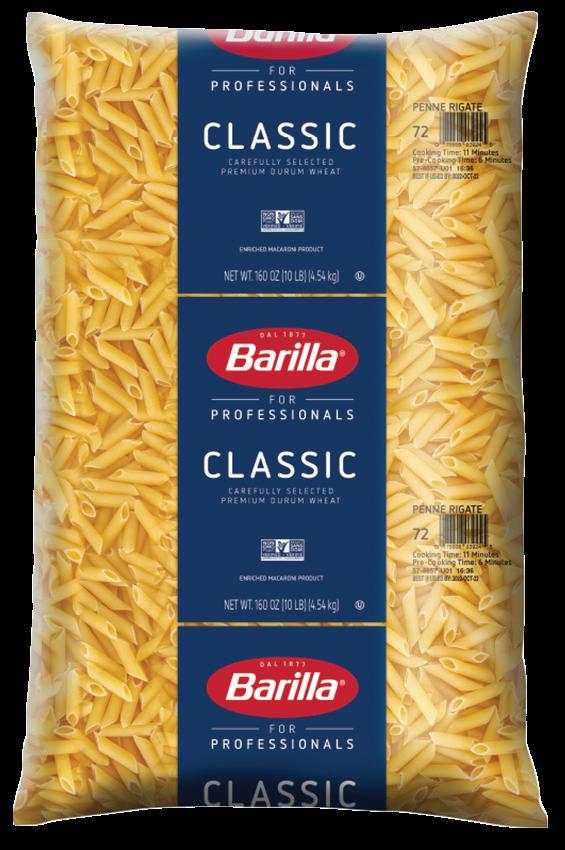


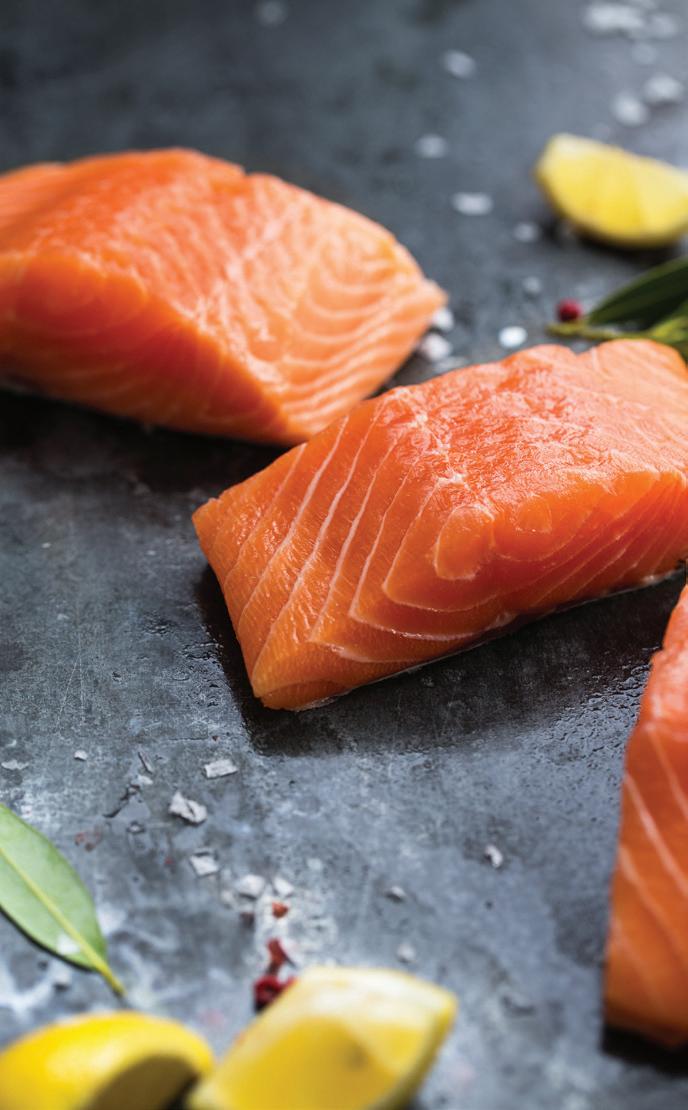







MENTIONED IN THIS SECTION NORTHERN SOUL • • BIG E • • RADIO STAR

NORTHERN SOUL SMOKEHOUSE OFFERS
APPETIZERS LIKE FRIED OYSTERS WITH CAJUN REMOULADE, PICKLED RED ONION, AND FRIED PARSLEY; AND FULL ENTREES INCLUDING SMOKED CHICKEN, RIB, OR BRISKET DINNERS.
BY CALLIE EVERGREEN“Iron Chef” champ Justin Sutherland is refocusing his priorities after a near-death experience.
IT STARTED OUT as an early Fourth of July celebration for celebrity chef Justin Sutherland—relaxing out on the boat with friends on the St. Croix River— when the unthinkable happened. A gust of wind blew his hat into the water, and as Sutherland casually reached back to grab it in the air, the boat hit a wake and knocked him off balance, causing him to fall overboard. In a freak accident, the boat had drifted directly above him, and in trying to swim to
the surface, he swam face first into the propeller. The impact knocked him out, and though his friend was able to rescue him out of the water, he sustained life-threatening injuries that left him in the hospital for months. He very nearly lost his eyesight, and shattered his cheek bones, arm, eye sockets, and entire upper row of teeth.
His world hit pause the summer of 2022. Instead of hitting the road for his two scheduled TV projects, he was focusing on recovering—which he did remarkably quickly, given the circumstances. In an Instagram post showing his stitched-up face, Sutherland wrote, “The pain means you’re alive. The scars mean you’ve survived.”
Often, near-fatal experiences can cause peoples’ priorities to shift. “I think that’s inevitable. I don’t think you have much of a choice for it to change you or not,” Sutherland says. “When you really realize how life can be cut short so fast, you can’t help but think about the things

GO-TO
you put your energy or effort into that maybe weren’t worth it, or some of the other things you’ve neglected that you wish you had paid more attention to. I think you naturally reevaluate and restructure your life and make sure you’re being true to yourself and doing the things that best serve you and your goals.”
“It’s been a very big paradigm shift for me,” adds Sutherland, nearly two years after the accident. “There were ultimately some silver linings that came out of it, for sure. I think you just walk through your life with a lot more gratitude and grace, giving understanding that everybody is potentially going through some wild sh*t in their own lives.”
For Sutherland, laying in a hospital bed for weeks meant more time to read, reflect, write, and ultimately, finish his cookbook, “Northern Soul: Southern-
ipes. It also gave him a chance to refocus his attention on the restaurants he sees the most growth potential for, including Northern Soul, his barbecue soul food concept, and Big E, his luxury egg sandwich shop.
Northern Soul is designed to fit in a variety of spaces, and currently has a more casual location in the Minneapolis-St. Paul Airport as well as a more expansive format, named Northern Soul Smokehouse, at the Grand View Lodge in Nisswa, Minnesota. “They’re just different footprints for different locations, everything from concession to full-service to barbecue,” he says.
The airport iteration focuses more on hand-battered buttermilk chicken sandwiches, wings, tenders, and a few salads and sides, while Northern Soul Smokehouse offers a more extensive menu, including appetizers like fried
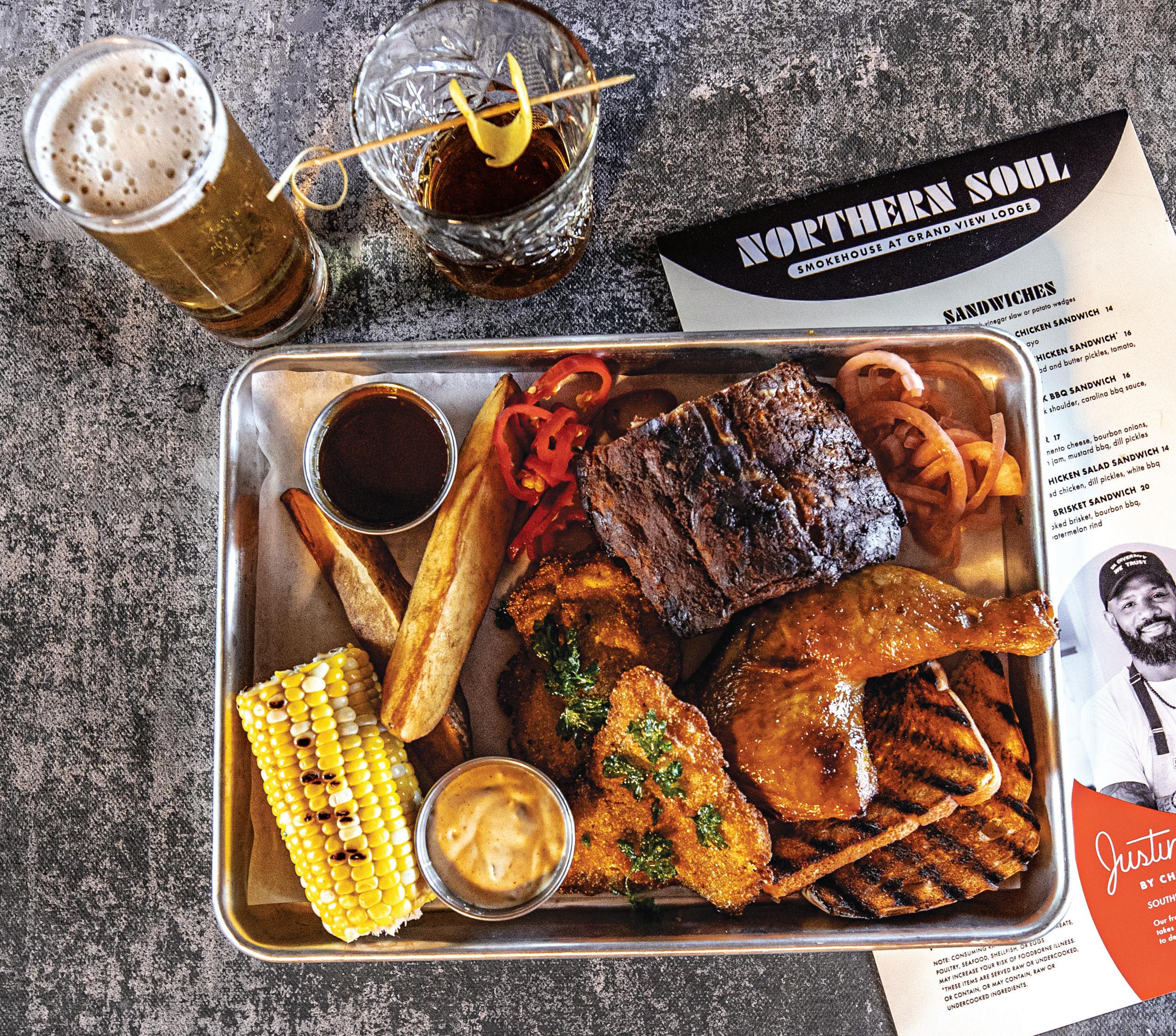







































toast, and pickled watermelon rind; and full entrees including fried catfish, and smoked chicken, rib, or brisket dinners. There are additional Northern Soul locations in the works for Minneapolis and St. Paul, and Sutherland is in talks about expanding the concept outside the state.
“We’re looking for the best locations within places, so we’re not ruling any -
examples: “Dark Side of the Moon” (by Pink Floyd), a sandwich with a sunny egg, shaved ham, dijon mustard, and Tillamook smoked cheddar cheese sauce; “Somebody to Love” (by Queen), which has housemade fennel sausage, dijonaise, and Tillamook swiss cheese; and “California Love” (by Tupac Shakur), with egg whites, avocado puree, spinach, tomato,
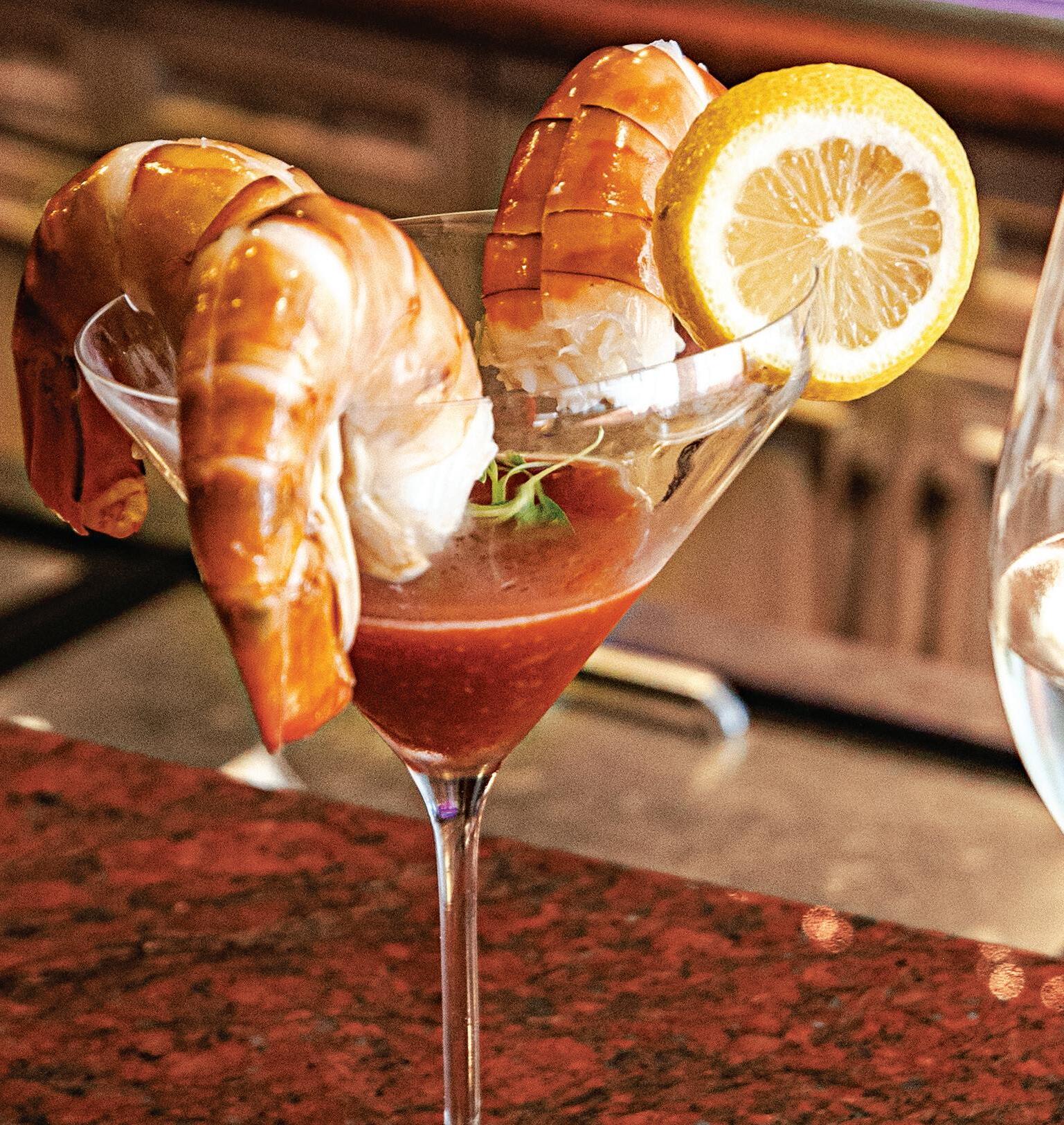
“There are plenty of restaurants out there. There are plenty of different versions of this culinary and hospitality and foodservice world … [Don’t] settle for anything because you feel like you have to.”
thing out. We’re heavily looking at Atlanta, Chicago, some local Midwest college towns—we’ve been looking in Milwaukee, so kind of all over and anywhere and everywhere,” Sutherland says.
So far, Big E has locations in St. Paul, Minnesota, and Portland, Oregon. While Big E leans more on the fastcasual, counter-service side, there is a model for a full-service restaurant if the right location and demographic presents itself, he notes. Sutherland infused his love of music into the concept by naming a lot of Big E’s menu items after his favorite songs, albums, or bands. A few
cucumber, alfalfa sprouts, and mayo. While franchising isn’t off the table, that decision will be made down the line when Northern Soul and Big E ideally have 10 to 12 locations. “Then, if and when we get to that level, then we would definitely look to franchising, but not yet,” he says.
Previously, Sutherland has helped open and operate a myriad of restaurants around the Twin Cities, including Handsome Hog, The Gnome, Woodfired Cantina, Chickpea Hummus Bar, Obachan Noodles & Chicken, Eagle Street Grille, Ox Cart Rooftop, and more. His venture
into the TV cooking competition world led to him competing on “Top Chef” and bringing home the championship title of “Iron Chef” in season 16 of the Food Network show. Plus, he launched his own show on TruTV called “Fast Foodies” alongside “Top Chef” alums Kristen Kish and Jeremy Ford, who compete to recreate and reimagine a celebrity guest’s favorite fast-food dish.
As for the future, Sutherland is staying busy, but focusing on the things that bring him the most joy. He has plans for “definitely a lot more TV,” he says, adding that he’s filmed about four pilot episodes over the past year, and aims to relaunch his spice line brand with some added sauces that he hopes will hit the shelves in the next year. He plans to start working on another cookbook, and is also on the lookout for the perfect location to bring back one of his past concepts called Pearl & the Thief, a Southern-style whiskey and oyster bar that opened in May 2018 in Stillwater, Minnesota, and closed in order to relocate to Minneapolis before plans were halted during the pandemic.
“I’d scaled back quite a bit post-pandemic, kind of let go of quite a few of the restaurants to focus on the restaurants that I myself and my restaurant group fully own, so we’re really just focusing on three concepts—Big E, Northern Soul, and we are currently looking in Minneapolis for a location to bring Pearl & the Thief back,” he says.
Sutherland’s advice for chefs who are just beginning their culinary careers is to “find a place that makes you feel happy and that you feel fulfilled and you’re constantly learning,” he says. “There’s so many options and opportunities out there. I think in the past, we’ve worked or felt obligated to stay somewhere that we weren’t happy, putting up with things we normally wouldn’t put up with in our daily lives,” he adds.
“There are plenty of restaurants out there. There are plenty of different versions of this culinary and hospitality and foodservice world … [Don’t] settle for anything because you feel like you have to.”
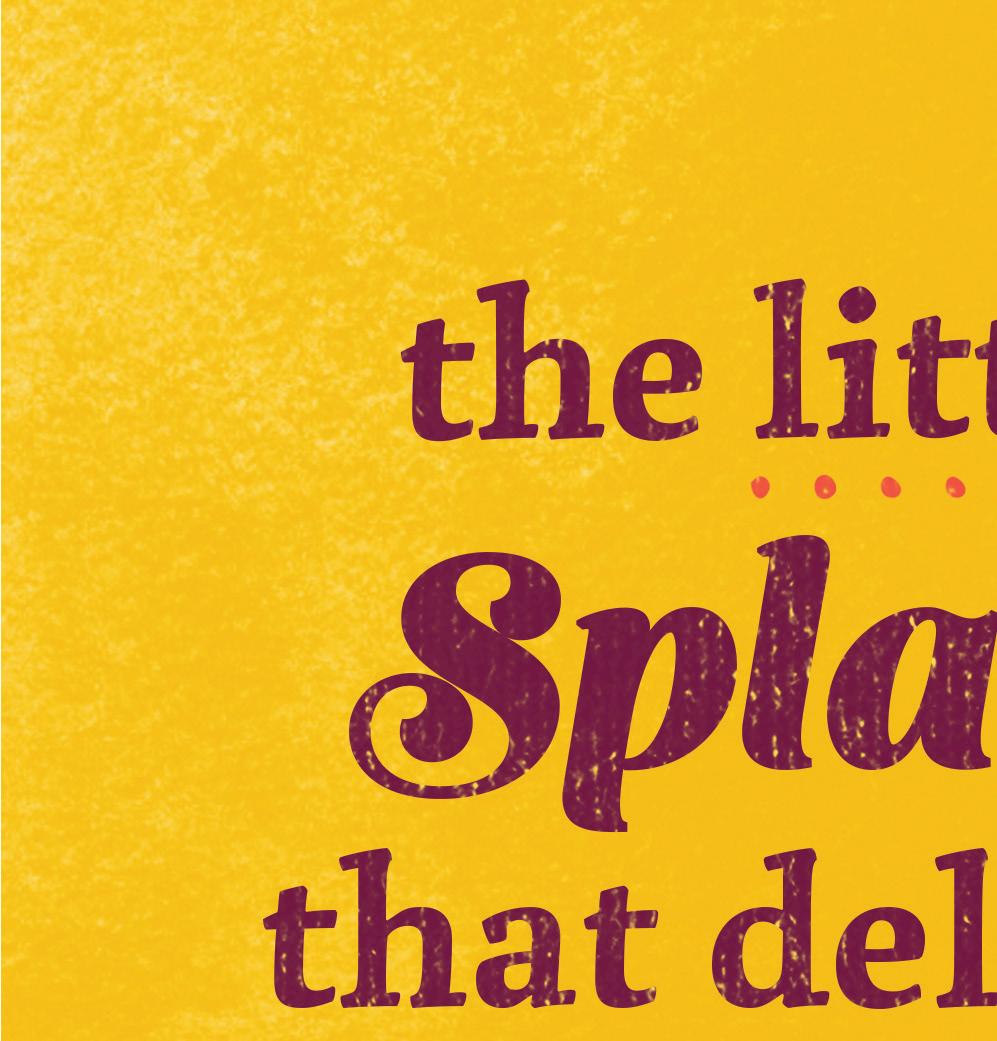











WHAT DOES A MEDITERRANEAN SPOT in New York City have in common with the history of radio? More than you might expect.
Radio Star opened its doors in Brooklyn, New York’s Greenpoint neighborhood late last year, taking its name from Transmitter Park across the street, where the WNYC station set up its antenna back in 1937. The business pays tribute to that legacy with fixtures and furnishings straight from the time period, along with clever radio-themed cocktails.
It’s the second venture from proprietor Sara Conklin, who has owned and operated the nearby acclaimed Glasserie restaurant since 2013. Like Radio Star, the upscale Mediterranean concept takes a cue from its location inside a former glass factory, with a menu inspired by Conklin’s Lebanese heritage.
“I grew up watching my grandmother chain smoke cigarettes while making savory hand pies, and those flavors are seared into my memory,” she says. “Honestly, I felt that Mediterranean food was
RADIO STAR IS A MIX BETWEEN A CLASSIC 1940S AMERICAN DINER AND AN ITALIAN TRATTORIA, WITH A FOCUS ON MEDITERRANEAN FOOD AND HOSPITALITY THAT TIES BACK TO THE TECHNOLOGICAL NAMESAKE.
not represented well at all 11 years ago. That was a big part of the impetus to open Glasserie.”
A lot has changed since then. The Mediterranean region encompasses roughly two-dozen countries with diverse culinary traditions that share a common emphasis on staples like olive oil, whole grains, fresh produce, and lean proteins. That health halo played a big part in the cuisine’s growing prevalence on menus across categories and service models in the decade since Conk-

Our Bavarian Pretzel Bites are on track to be one of the most profitable products for menus everywhere. A delightful taste, these bites have the versatility to fit on any menu and be served in every daypart. Oh, and they’re good at making customers smile.

lin opened her first restaurant.
“Now, I think it is actually very well represented, so if you’re going to dub yourself Mediterranean today, you either need to go very specific and find a real niche, or you need to get a little weird and take some liberties with it,” she says.
Radio Star falls squarely into the sec ond camp. Conklin describes it as a mix between a classic 1940s American diner and an Italian trattoria, with a focus on Mediterranean food and hospitality that ties back to the technological namesake. Radio made the world feel smaller and more connected when it emerged in the early 20th century. Similarly, Radio Star aims to be a community hub of sorts. There’s ample outdoor seating and a siz able private dining space capable of host ing up to 150 people. The front of the house is anchored by a bar that captures the feel of a friendly neighborhood diner,





















SIGNATU RE YELLOW ASI AGO

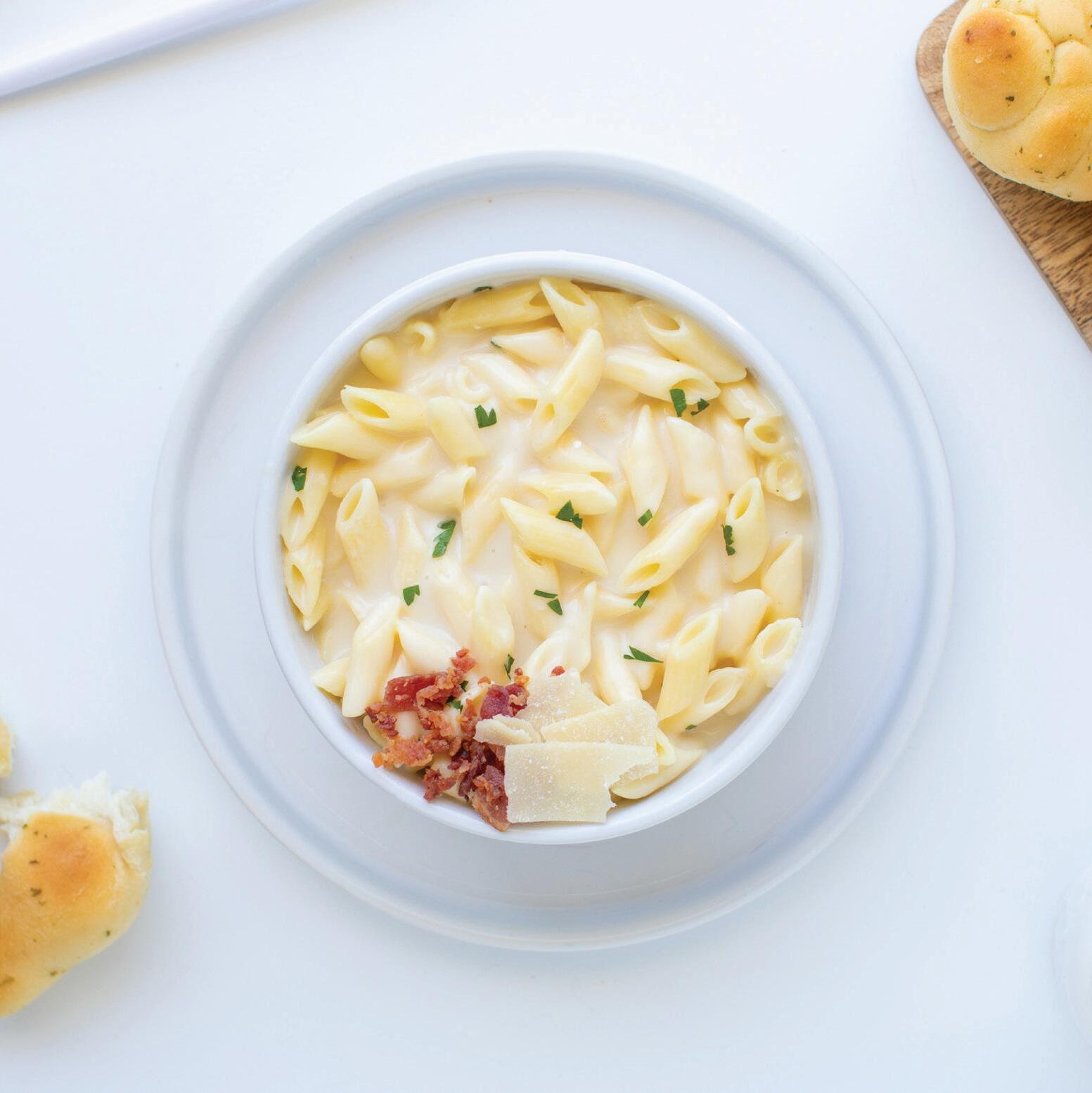
It’s in the bag! I t ’ s i n t h e b a g !
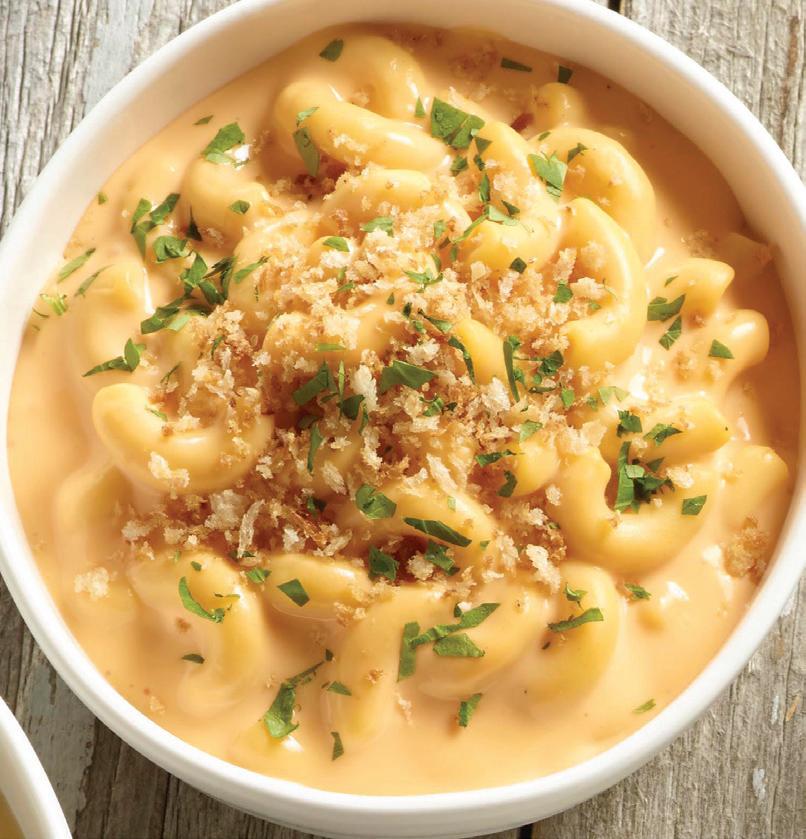


Our Family of Brands REQUEST


AT FAROW IN NIWOT, COLORADO, 90 PERCENT OF INGREDIENTS ARE SOURCED WITHIN 10 MILES FROM FARMERS THAT ARE DOING A LOT OF ORGANIC AND REGENERATIVE FARMING. THE CREATIVE BEVERAGE TEAM IS UTILIZING THESE KITCHEN SCRAPS FOR COCKTAILS INSTEAD OF SIMPLY GOING INTO THE TRASH.
BY KRISTEN KUCHARRestaurants are reducing beverage program costs with eco-friendly methods.
A RESTAURANT’S sustainability efforts have the power to not only improve the environment, but also attract more customers. In fact, 38 percent of consumers are more likely to choose a restaurant with locally sourced foods, and
30 percent would choose a restaurant with food grown in an environmentally friendly way, according to a recent industry report from the National Restaurant Association. But it doesn’t end with food. In fact, sustainability in a
restaurant’s beverage program is a vital piece of the puzzle. The same report showed that restaurant goers value local wines and beers (48 percent of Millennials and 40 percent of Gen Zs).
Implementing more sustainability efforts at the bar can make a positive impact on the environment and potentially save money and bring in new cus -

“If you’re a restaurant that aims to be a certain voice in your marketplace, then the beverage program should follow suit.”
list are also sustainably produced and/ or natural wines.
“One of the cool things about using local wineries is you get to know the winemakers,” he says. Similar to how many restaurateurs strive to know their farmers, the same benefits are true when it comes to knowing their brewers, winemakers, and distillers, he adds. “It’s just one step closer to production and knowing where your food and wine comes from.”
In addition to local wineries, Marshall says a restaurant can opt for wineries that have a sustainability certificate.
important to keep price point in mind when selecting beverage products to maintain margins.
“Most of our customers really appreciate that we’re taking farm-to-table to the next level,” Marshall says. Besides wine, the spirits are all from New York distilleries; even the soda is made right in Brooklyn. If operators don’t have access to the wine selection that a New York restaurant does, he says to start with beer, since it’s easier to find a great local brewery.
Bethany Heinze, owner of Vern’s in Charleston, South Carolina, agrees that

tomers. Charles Marshall, owner and chef at The Marshal in New York City, has always curated a completely local wine list. “What we decided here very early was if we were going to open a farm-to-table restaurant, that was going to be represented in the beverage program,” Marshall says.
Not shipping wines from France, Chile, and other destinations around the world reduces the restaurant’s carbon footprint, and also puts money back into the local economy. Marshall finds restaurant goers often discover a local winery on the menu, which inspires a trip to check it out and further helps the local economy. Many offerings on the
Some best practices to look for include protection and conservation of the water supply, little to no use of pesticides and/ or herbicides, sustainable electricity use, and maintaining a healthy soil platform that will allow continued future use of the land.
His advice to adding local wines is to find wines that fill a slot on the menu and customer demand—something similar to a Cabernet Sauvignon, for example. Offering wines by the glass opposed to only by the bottle allows customers to try local wines they’re not familiar with. It’s also important to educate staff on how to sell it. He notes it’s easy to get lost in the romance of buying local, but it’s
MAKE SURE TO INFORM GUESTS THAT YOUR WINE LIST IS INTENTIONAL WITH A GOAL TO SUPPORT SMALL PRODUCERS WHO SHARE YOUR RESTAURANT’S SAME ETHOS IN SUSTAINABILITY.
sourcing local ingredients is a priority.
Heinze loves the concept that a wine is an agricultural product first and foremost, and believes the farming behind the fruit is really important. Vern’s wine menu highlights small producers who follow a low-intervention approach to farming and winemaking, emphasize sustainability, and produce organic and natural wines.
“If you’re a restaurant that aims to be a certain voice in your marketplace, then the beverage program should follow suit,” Heinze says.
The farm-to-table movement is still transitioning into the beverage world, Heinze says, and there’s still a long way
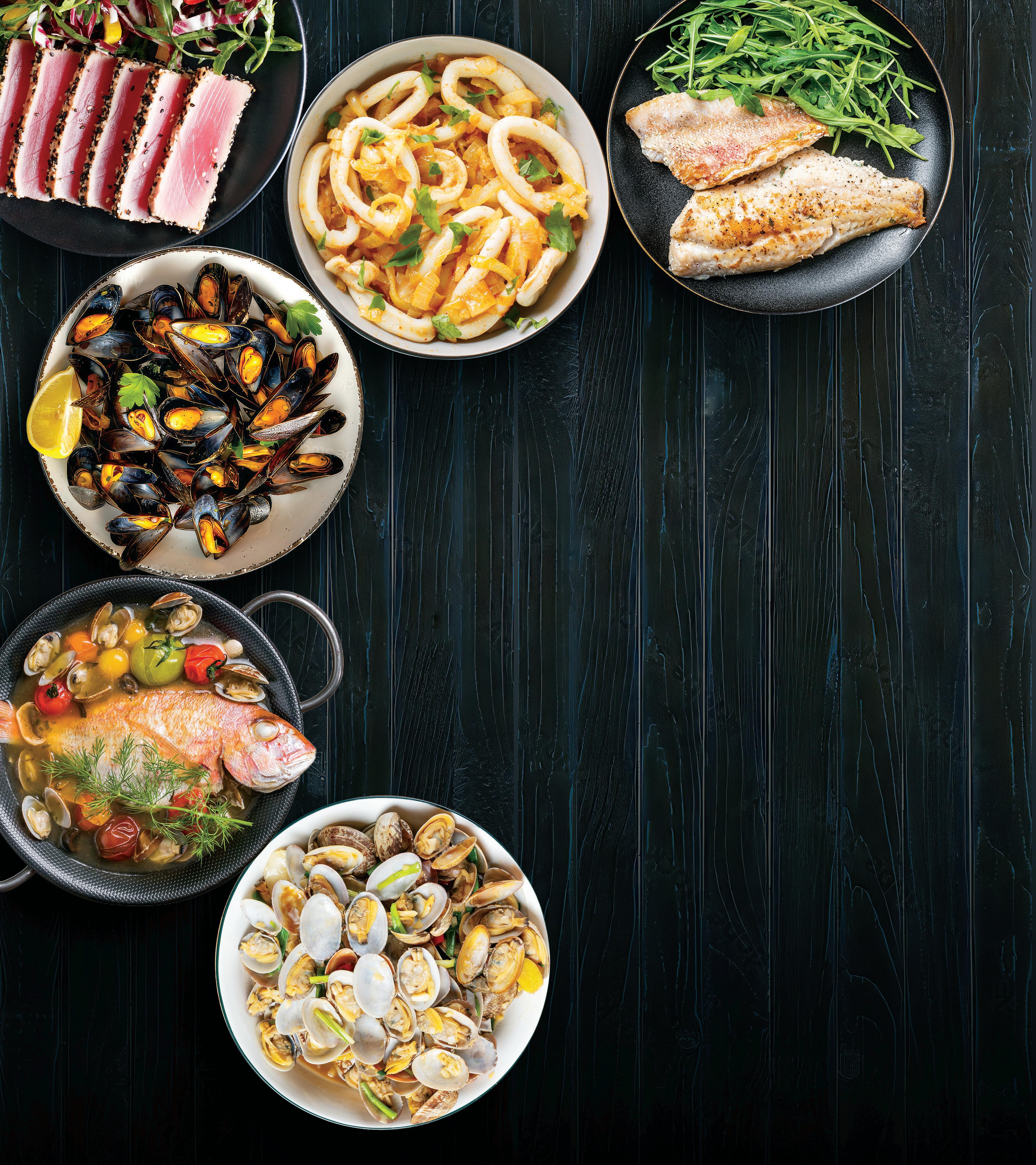
IT’S EASY TO GET LOST IN THE ROMANCE OF BUYING LOCAL, BUT IT’S IMPORTANT TO KEEP PRICE POINT IN MIND WHEN SELECTING BEVERAGE PRODUCTS TO MAINTAIN MARGINS.
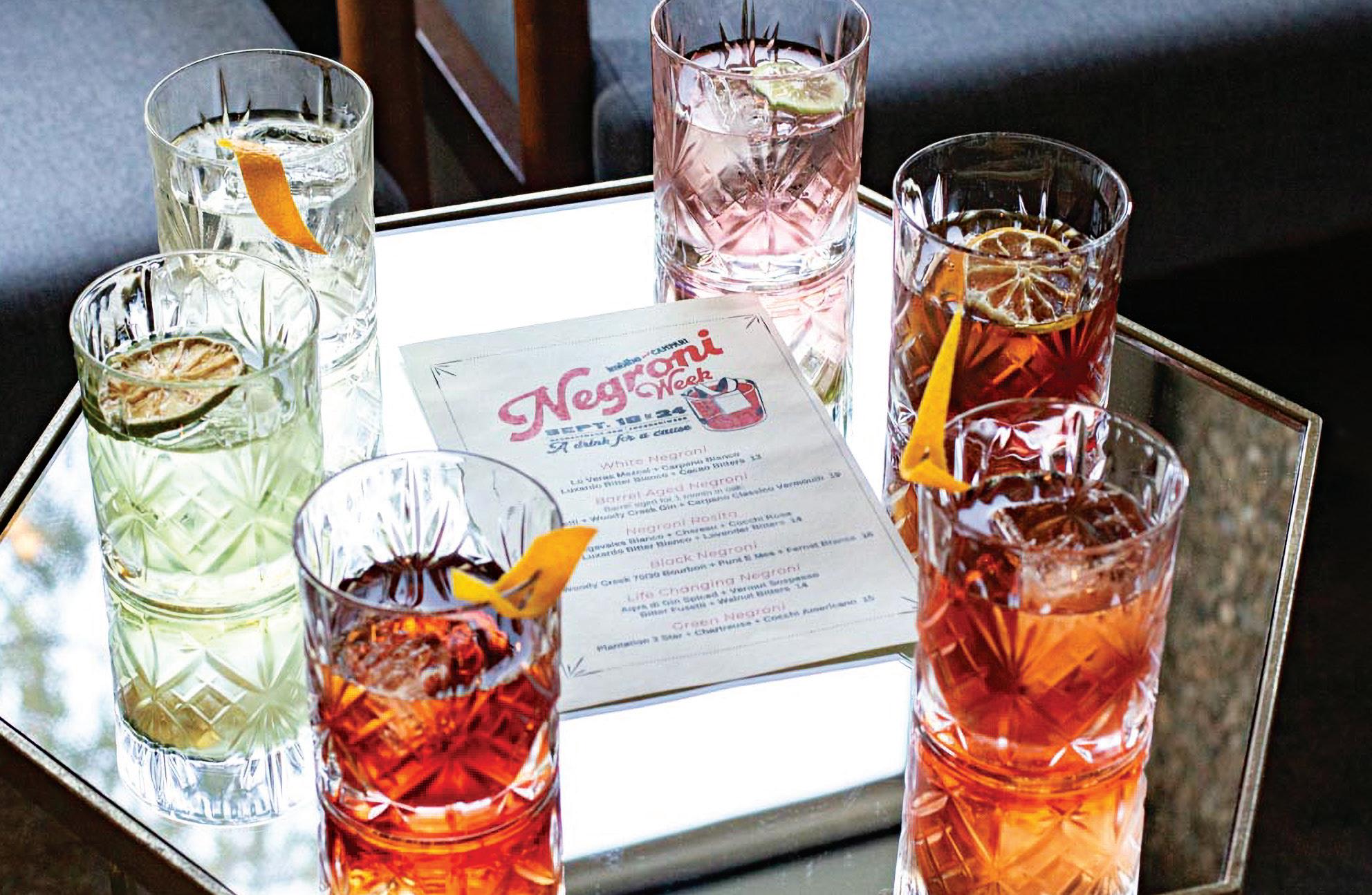
“It would be counterproductive to have such a focus on sustainability and clean food and not to continue that on our beverage program.”
to go as many people still tend to rely on things they know and producers they recognize. Having these types of wines can be a challenge, but can also be a lot of fun, she says.

A priority is informing guests that the wine list is intentional with a goal to support small producers who share the restaurant’s same ethos in sustainability. To make the wine list easier to navigate, there are sub-sections of wines such as white wines under light, clean, and crisp; or silky, weighted, and refined. Employees participate in a weekly wine training to build vocabulary on describing what to expect in a wine.
Cocktails at Vern’s are often made with vermouth, sherry, and fortified wines from those same small producers. Produce is cross-utilized in both the kitchen and the bar, such as in a seasonal herb syrup used in cocktails,
which are currently basil, tarragon, and mint. When the kitchen is only using egg yolks in a recipe, the whites are used in cocktails. Soda and juice are made inhouse to limit waste, and beer selection focuses on local.
Meanwhile, at Farow in Niwot, Colorado, 90 percent of ingredients are sourced within 10 miles from organic and regenerative farms. The creative beverage team is utilizing these kitchen scraps for cocktails instead of simply going into the trash.
“The biggest part of it is not letting anything go to waste,” says co-owner Lisa Balcom.
Peels of citrus and other fruit scraps are macerated with sugar and utilized
in drinks, tops of celery are used to make a tincture to add to cocktails, and bitters are made from leftovers, such as apple peels and pumpkin scraps. The bar utilizes pumpkin peels for a tepache, a fermented drink typically made with pineapple peels, and spent coffee grounds are turned into coffee bitters.
Leftover fats from meat, such as chicken and lamb, are used in various fat-washed cocktails, and there’s even a cocktail that’s garnished with scrap crispy chicken skins.
In addition to potential waste, an on-site garden grows lilac for a lilac-infused vodka, chamomile and mint for simple syrups, and lavender for bitters.
For Farow’s wine selection, the focus is on producers that are biodynamic and organic. With offering lesser-known wines, it means investing more effort into educating guests on the list, Balcom points out. Overall, she has found people are curious and open to exploring and enjoy these wines.
“It would be counterproductive to have such a focus on sustainability and clean food and not to continue that on our beverage program,” Balcom says.
Having these sustainability efforts in the beverage program just continues to highlight more of the restaurant’s goals. “It does require learning and becoming more educated,” she adds. “It’s just a matter of the drive and desire.”
For a restaurant wanting to implement sustainability efforts, pick one thing and start there, she says. There are many options for a beverage program to get started—rethink single-use items such as straws and plastic skewers, opt for edible garnishes, recycle and compost whenever possible, evaluate energy and water usage, and if offering to-go cocktails, consider eco-friendly packaging.





From resurrecting the iconic Steak and Ale brand to bringing back relevance at Bennigan’s, Paul and Gwen Mangiamele are on a mission to revolutionize casual dining.
BY CALLIE EVERGREENWhat kind of person is gutsy enough to bring back an iconic restaurant chain after it’s been shuttered for nearly two decades? They would have to push past the fear of not living up to the hype or peoples’ expectations, and be 100 percent sure they could deliver a top-notch experience. They would also need the right people and systems in place in order to grow the concept back to its original glory, at a pace that matches the pent-up market demand. They’d need to be someone who didn’t let naysayers slow them down.


the bold soul who is resurrecting Steak and Ale—the Norman Brinker-founded restaurant that first opened in 1966 and became known for introducing the salad bar. Mangiamele has more than 30 years in the hotel, restaurant, franchising, and retail industries, in both private and public organizations.
Widely considered the early model for casual dining, Steak and Ale was founded on the premise of providing great steaks at affordable pricing and attentive, friendly service in an intimate yet comfortable environment. Inspired by the warmth of an English inn, the concept took off and grew to nearly 300 locations by the 1980s.
But it had an unfortunate ending in 2008 with a Chapter 7 bankruptcy that left its sister concept, Bennigan’s, in big trouble, as well. All 150 corporate Bennigan’s closed with the bankruptcy filing, though some franchise locations remained open. Steak and Ale shuttered the remaining 58 at the time of the bankruptcy filing.
A former CEO of Salsarita’s, Mangiamele was originally brought on by Bennigan’s former owner, Atalaya Cap -
ital Management, to lead the chain’s turnaround. But in February 2015, along with his wife, Gwen, Mangiamele completed a 100 percent acquisition of Bennigan’s Franchising Company and Steak and Ale from Fortress Investment Group.
“I saw this: The brands are diamonds,” Mangiamele says. “They were diamonds, [they] just had to be polished up, had to be loved, had to be nurtured, [and they] had to reward people for hard work. We had to replace the culture that was part of the original piece that Norman Brinker built way back with the S&A core. So that was key. But the other key to it was to put your own money up.”
The Mangiameles formed Legendary Restaurant Brands LLC, with a mission to revolutionize casual dining by reintroducing beloved, legacy restaurant brands that people are nostalgic for, but


THE NEW MENU AT STEAK AND ALE WILL FEATURE CLASSIC FAVORITES LIKE THE KENSINGTON CLUB STEAK, HAWAIIAN CHICKEN DINNER, AND OF COURSE, THE LEGENDARY GIANT SALAD BAR, ALONG WITH ADDING SEVERAL MODERN TOUCHES LIKE A PRIME RIB CARVING STATION.
give those concepts an upscale makeover and grow at a sustainable pace.
“My wife and I, we put our life savings on the line,” he notes. “I was brought up a poor kid from New York City. Every dollar I ever earned I worked my butt off for. Same with my wife. There’s no golden spoon, there’s no graduating from Yale and Princeton and Brown and having a father or family that has a random business that I inherited and then ruined it. No, it wasn’t that situation at all.”
The power couple has been hard at work bringing back relevancy, sales, and locations to Bennigan’s, the Irish pubthemed American restaurant founded in 1976 in Atlanta. Bennigan’s became known for its friendly atmosphere and craveable American fare, from Prime halfpound burgers and sandwiches—including the World-Famous Monte Cristo—to favorites like Oh, Baby Back Ribs.



Now operating out of Dallas, the chain came out on the other side of ownership changes and restructuring and is already reaching new heights. One recent example: the 2022 romantic comedy “About Fate”—starring Emma Roberts, Lewis Tan, Madelaine Petsch, and Thomas Mann—kicks off with a scene at Bennigan’s, and several more key scenes are set inside the restaurant.
Producers of the movie who were familiar with Bennigan’s reached out to Mangiamele beforehand, looking for a family friendly setting. He pulled various Bennigan’s pieces out of storage, and his team packed a truck with menus, T-shirts, and a neon green logo and road tripped to Boston, where they shot the movie in a previously shuttered venue. The Mangiameles were even extras in the movie, sitting in a booth behind Tan and Roberts during one scene. “When I saw
how many times Bennigan’s was mentioned and how so many scenes were shot in the Bennigan’s, it’s was like, holy mackerel, this is like a billion-dollar commercial,” Mangiamele previously told FSR Bennigan’s currently has 10 locations open in the U.S. in Illinois, Iowa, Michigan, Nevada, North Dakota, and Texas, including three “On the Fly” units (the brand’s fast-casual iteration), plus 15 international restaurants. Bennigan’s On The Fly creates more diverse franchising opportunities and attracts a new demographic; while the typical full-service Bennigan’s sites are free-standing, 5,200-square-foot restaurants with full bars and patios, the quick-serve model is flexible and can fit in nontraditional venues like airports, arenas, hotels, food halls, and more. Mangiamele previously told QSR more than a dozen were in the development pipeline with more room for growth, from ghost kitchens to international markets such as the Middle East and Central America.
“Everything has its cycle. And I think we are timely in the reintroduction or resurrection and the renaissance of Bennigan’s and Steak and Ale, and then Bennigan’s On the Fly,” Mangiamele adds.
So one might ask, why exactly is now the right time for Steak and Ale’s comeback?
For one, instead of trying to define a niche, Mangiamele says he’s capitalizing on the pent-up demand of legacy brands that already have awareness, with the ultimate goal of achieving global market share capture.
Another reason is more personal. “It’s truly a labor of love. I grew up with these brands myself,” Mangiamele says of the 58-year-old Steak and Ale and 48-yearold Bennigan’s. “And they develop very strong emotional connections, and emotional connections in the business world equals revenue, and revenue and the ability to create high-revenue restaurants, in a day where there's a lot of failure and not a lot of successes, speaks vol-
umes for the emotional connections that were created so many years ago.”
The power of that nostalgia is perfectly exemplified by the Facebook group called “Steak and Ale’s Comeback,” which was created in 2013 and has grown to nearly 55,000 followers. That group has become a kind of playbook for Mangiamele, with wish-list cities and former employees reminiscing about how great it was to work for the company.
On April 23, Mangiamele posted an update in the group that his team is accepting domestic and international applications for people or groups interested in owning a franchise. “After years of fits and starts, after battling COVID, naysayers, rising interest rates, inflationary pressures, supply chain disruptions and a host of other headwinds, we are now heads down, swinging away and under construction on bringing back everyone’s favorite iconic brand: Steak and Ale!”
“The responses to our updates are heart warming and reassuring to read,” the post continues. “It’s an interesting dynamic as when most brands open they try in earnest to CREATE market share, in our case, we already have amazing awareness, BUILT IN MARKET SHARE CAPTURE and PENT up demand. An envious position to be sure and one, (of course, coupled with legendary execution), that will overcome the obstacles that most franchisors contend with every day.”
To kick things off, Legendary Restaurant Brands struck an area development agreement early last year with Kansasbased Endeavor Properties that plans to bring 15 new locations to several markets across the U.S. Endeavor holds exclusive rights for expansion in Minnesota, Kansas, Missouri, Nebraska, North Dakota, Oklahoma, and South Dakota.
The debut of the first new Steak and Ale location to open since 2008 will be in Burnsville, Minnesota, which as of press time was still in construction and slated to open in summer of 2024.
The new Steak and Ale will be housed in a 6,000-square-foot space with the ability to accommodate 220-225 guests,

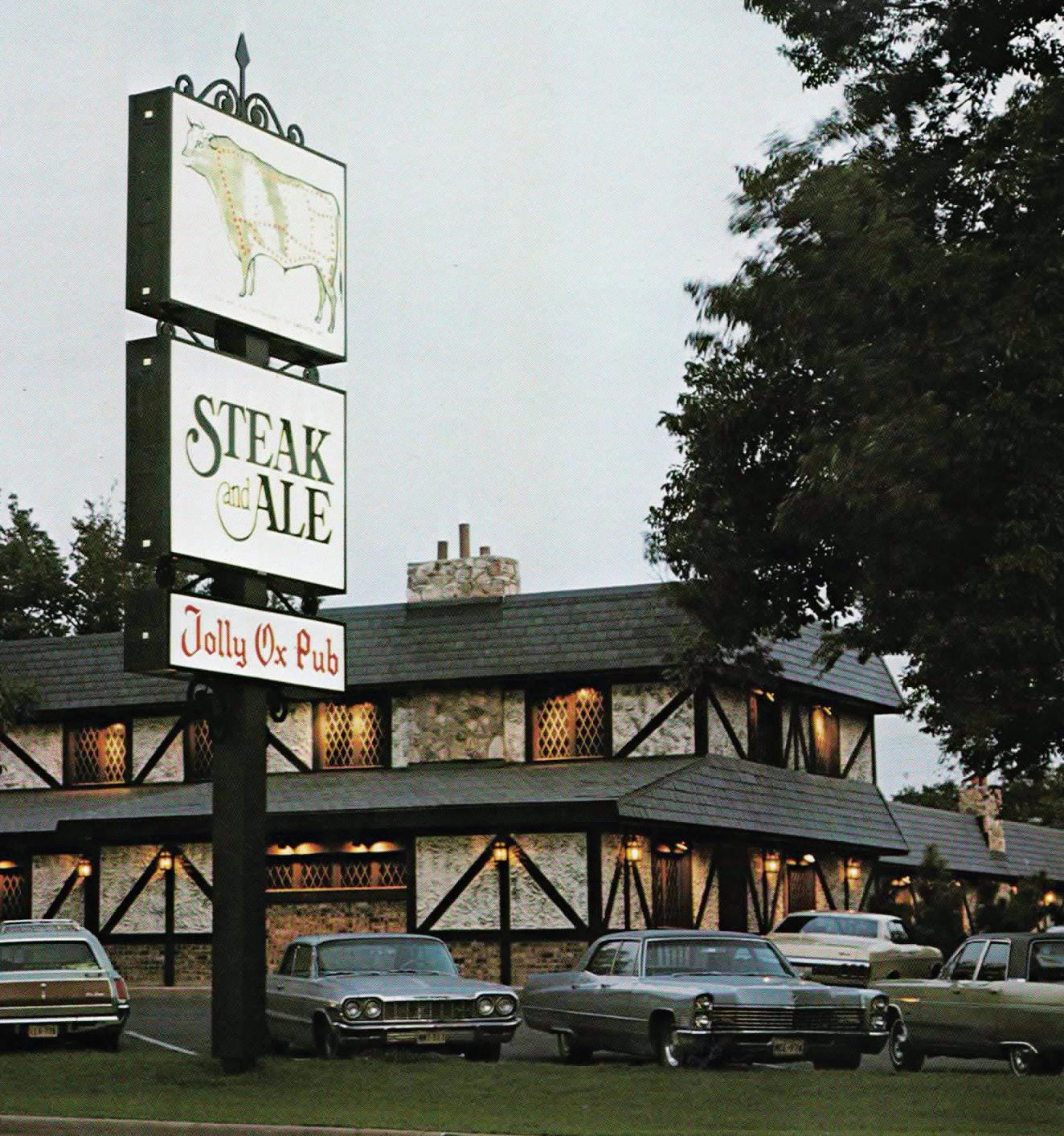



INSPIRED BY THE WARMTH OF AN ENGLISH INN, NORMAN BRINKER FOUNDED STEAK AND ALE IN 1966 AND GREW IT TO NEARLY 300 LOCATIONS BY THE 1980S. BUT IT HAD AN UNFORTUNATE EARLY ENDING IN 2008 WITH A CHAPTER 7 BANKRUPTCY. NOW, LEGENDARY RESTAURANT BRANDS IS BRINGING STEAK AND ALE BACK TO LIFE.
1966 Steak and Ale is founded by Norman Brinker in Dallas
1980s The chain has grown to 280 locations across the country
2008 All remaining locations closed as part of a Chapter 7 bankruptcy proceeding
2013 A Facebook group is created titled “Steak and Ale’s Comeback,” which has grown to nearly 55,000 followers
2015 Paul and Gwen Mangiamele buy Steak and Ale and Bennigan’s from Fortress Investment Group
2015 The Mangiameles form Legendary Restaurant Brands LLC
2018 LRB adds a few Steak and Ale signature favorites to the Bennigan’s menu
2023 A 15-unit area development agreement is sold to franchise partner Roy Arnold
2024 The first new location is set to open in Burnsville, Minnesota
featuring a patio with hotel access as well as its own outside entrance. The restaurant will also handle food and beverage operations for the hotel— including room service, breakfast, lunch and dinner, late night, and delivery. It will even serve as a host kitchen for Bennigan’s. Day-to-day operations will be handled by franchisee Roy
not slow walking it, either. Nobody wants the doors to open faster than I do. But it has to be right,” he says. “You can't get this wrong. You have one chance to reintroduce and resurrect and enjoy the renaissance of Bennigan’s and Steak and Ale. And I feel like I owe it to those guests that have been tenacious and waiting for this to happen to get it right.”
ential,” he says. “I think if you fail on the experiential, where you don't really deliver a value for the experience— whether it's the music, it's the food, it's the service, and you fail on any one of the dozens of touch points, especially in a higher-end, casual-dining environment—you'll just have guest defection.”
“The resurrection of Steak and Ale

Arnold, CEO of Endeavor Properties.
As someone who coincidentally was born in Burnsville and raised in the Twin Cities, I had to ask Mangiamele why he chose this seemingly random city to reopen the first Steak and Ale after two decades. In addition to the property being a good fit to renovate in a prime spot by a Wyndam hotel, it just so happens that Mangiamele and his wife have a residence in nearby Eden Prairie. “My kids grew up in Minnesota. I know the state, I know the market, I know the demographics,” he says. “So when this came up, I said, ‘Man, you know what, we are in the middle of the sweet spot for Midwest, family friendly, high-value proposition, reintroduction of Steak and Ale.’ So that’s how the genesis of being in Burnsville became a reality.”
The projected opening estimate has been pushed back a few times, but Mangiamele won’t let it be rushed. “I’m also
In terms of the development process, Mangiamele and the team at LRB brands had to basically recreate the brand, then refine and improve upon every aspect— from food recipes and beverage menus to the tech, furniture, fixtures, kitchen equipment, and everything in between. Some elements will be kept the same: The new location will feature booths that are separated from each other with stained glass, like the originals. But the layout will be closer to 6,000 square feet than the old 10,000 boxes, and anchored by tech that makes the back-end work.
The demand for elevated, experiential dining isn’t going away anytime soon, which is an area where LRB will continue innovating and bringing new ideas to the table. “That’s where I think a lot of the brands out there missed the mark. They’re very transactional, not experi-

is propitious because of the defection that has occurred in many of the other casual-dining brands, and we’ll pick them up,” Mangiamele adds. “So not only will we have all those other components in place, but we’ll pick up market share of lapsed consumers to other brands. It’s a very enviable position now.”
The new S&A menu will feature classic favorites including the giant salad bar, the Hawaiian Chicken dinner, and Kensington Club Steak, along with several contemporary touches like a Prime Rib carving station with dramatic cast iron doors. An array of beer, wine and cocktails, tableside salad service, and Irish Coffee will also be offered.
“It will not be your downmarket offerings, but your upmarket offerings on the salad bar. We’re a scratch kitchen. Everything is hand-crafted, even from the beverage side. We’re going back to the speakeasy drinks, the traditional drinks,” he
says. “We’re introducing old-school back into the lexicon of our industry. Retro, ‘new-stalgia’ versus nostalgia.”
Mangiamele expects to do “ridiculously high volumes” when the first restaurant opens, and not just because members of that 55,000 Facebook group will travel from all over the country to visit. The restaurant will span all day -
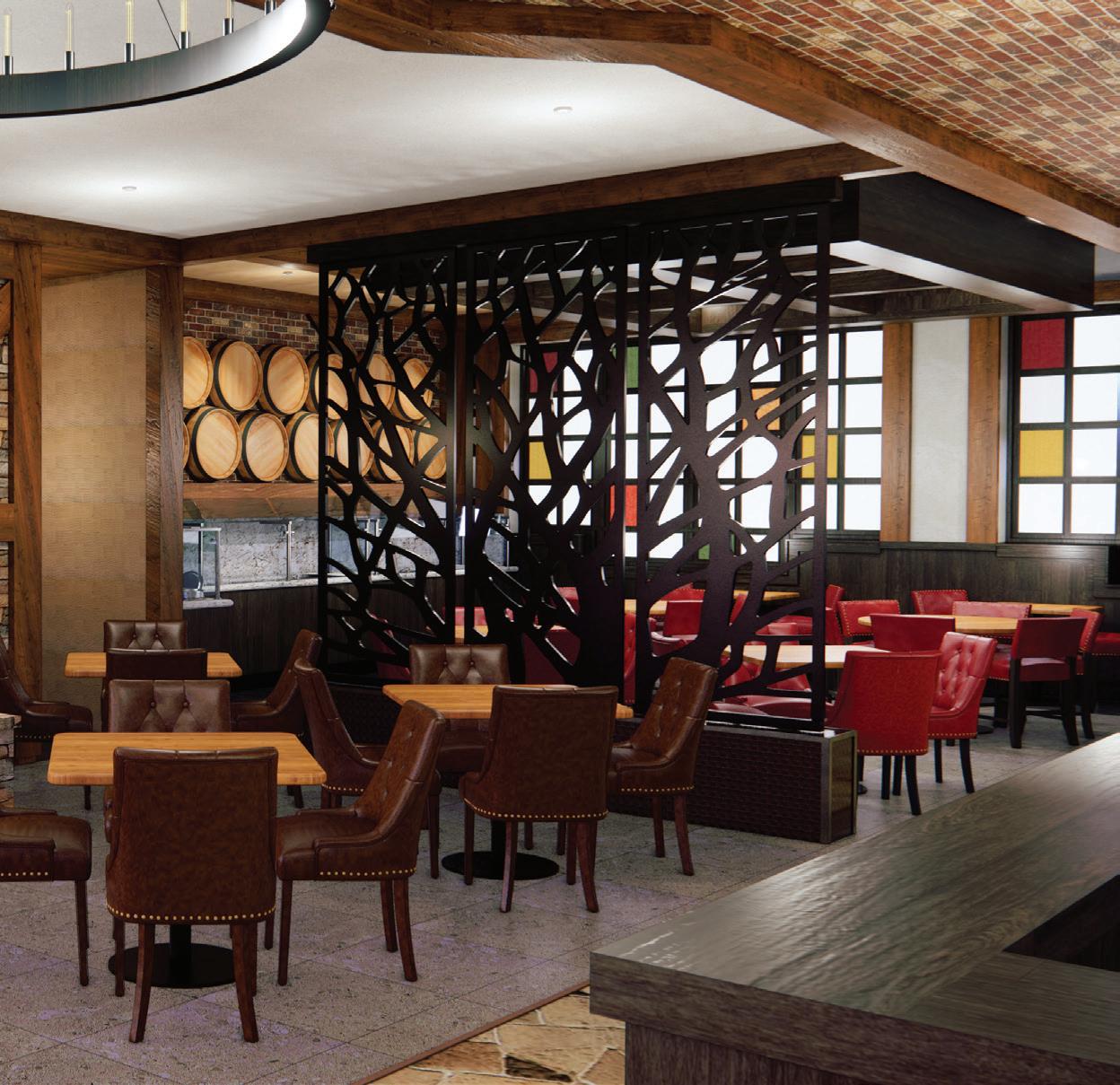
of growth doesn’t exist,” he says. “However, the demand for our products, our brands, does exist. I already know where to go, because we had hundreds of restaurants before. We already know the markets that were the best markets, whether it’s domestically or internationally.”
Because of that, Mangiamele has no desire to put a firm number out there
and the painstaking attention to detail that we’re taking to not just replicate it, but improve on what was created so many years ago.”
A mantra Mangiamele stands by is ABCD—going “above and beyond the call of duty” when it comes to hospitality and pleasing guests. “If you go out to eat today, you're spending hard earned

parts, from breakfast, lunch, and dinner to late-night, catering, room service, and banquet for the hotel, plus delivery.
“You just don’t quite know why you love this place, but you’re going to love it. And what does that equal? Frequency,” he adds. “And these are the things that everybody is trying to create in their brands. Some are guessing right, some are missing the boat entirely. But it all starts with the experiential.”
Mangiamele has seen it more times than he can count—a restaurant brand touting a ridiculous number, like opening 100 restaurants in two years, which never actually happens. “It’s folly to say that, because the environment for that kind
of the locations he’d like to have open someday. “I think there’s no reason to quantify that, as much as we have that demand. Now we have to meet that demand by scaling in the particular states and markets that were conducive to do business, where the unit economics of our franchise model makes sense,” he says.
The plan is to be deliberate and intelligent about where, how, and when they open new locations and expand to new markets in the U.S., though Mangiamele admits they’re already having conversations about international expansion. “I’ve asked everybody to be very patient. I know everybody is chomping at the bit, but they’ve got to realize that nobody wants it faster than I do,” he adds.
“If you’re going to paint on this beautiful palette of what Steak and Ale was and what it continues to grow into, you have to appreciate the deliberateness
money. And now, a lot more because of all the other headwinds that we've had to deal with, whether it's supply chain issues, or it's inflationary issues, or interest rate issues. I mean, you name it,” he explains.
The Mangiameles are working handson when it comes to training staff for this very reason. “Because again, I want to introduce something extraordinary. That again, delivers not only that value proposition, but something that goes ABCD, and speaks to our culture that I inherited from Norman Brinker, who was a friend of mine,” Mangiamele says. “And I think he'd be proud to look down and say, ‘thatta boy, go get them.’ The only two brands he ever created were the ones I own now with my wife, and I think that's cool.”
He adds, “But it’s also a legacy, because I never lost sight of the fact that I’m standing on the shoulders of those that came before us.”





2BHospitality is transforming fine dining with its two concepts, BellaBrava and Stillwaters Tavern.
AFTER WORKING for nearly 15 years as an operating partner for a large restaurant group, Thomas Sanborn was ready to exit the industry. But when a friend introduced him to 2BHospitality, he felt called back into the full-service space.
He quickly became enamored by the restaurant group’s people-first culture and promising portfolio, which included the Tuscany-inspired BellaBrava: New World Trattoria, and Stillwaters Tavern, a modern take on classic American scratch tavern fare. “I was trying to get out of restaurants, but that lasted about 24 hours before I met my partners at 2BHospitality,” says Sanborn, who joined the team in 2015 as director of operations.
“We aligned culturally ... I saw something in these brands that was new and had immense potential for the future, but just needed a little help getting across the finish line in terms of expanding,” he adds.
Within two years, Sanborn rose to his current position as president by helping to nurture BellaBrava and Stillwaters Tavern to maturity and redefine fine dining in the fast-growing region of Tampa Bay, Florida.
BellaBrava isn’t a new concept. It opened its doors in 2005, bringing a taste of contemporary Italian to downtown St. Petersburg, Florida, on the prime location of Beach Drive. The brand
STILLWATERS TAVERN IS A CONCEPT FORGED OUT OF THE COLLABORATION BETWEEN LOCAL ARTISANS, FARMERS, AND FORAGERS TO SERVE LOCALLY PRODUCED DISHES.

uses Wood Stone ovens to bake pizzas and calzones, with dough, sauces, and dressings made in-house from scratch.
Favorites like black truffle pasta, stuffed gnocchi, beef carpaccio, and hot honey pepperoni pizza pepper the menu, along with a wide variety of wines, beers, and cocktails including the Blackberry Ginger Smash, Strawberry Balsamic Martini, and the True Italian Martini.
2BHospitality introduced Stillwaters Tavern to St. Petersburg in 2014, just down the road from the original BellaBrava location on Beach Drive. The
ESTABLISHED: 2005
FOUNDERS: Robert Sanderson and Dyce Craig HQ: Tampa Bay, Florida
CUISINE TYPE: New World Italian + American Scratch UNITS: 4
American scratch kitchen and bar is a concept forged out of the collaboration between local artisans, farmers, and foragers to serve locally produced dishes.
The menu features classic American twists like the Crispy Pork Belly, Cuban sandwich on locally baked La Segunda bread, Fried Chicken Salad, and Smoked Beef Knockwurst. Brunch staples include the Honey Bourbon Smoked Salmon Benedict, Stuffed French Toast, and Chicken & Waffle-Wich.
Like BellaBrava, Stillwaters Tavern boasts a robust spread of house cock-


tails, brunch specials, and wine. Both concepts include an option to buy the kitchen staff a round of beer for only $5 or an unseasoned burger patty for the four-legged member of the family, with a $2 donation given to Southeastern Guide Dogs for each purchase.
Sanborn believes it’s little gestures like these that build a sense of community within the restaurant’s four walls. 2BHospitality has built a reputation as having a people-first culture through an emphasis on repeat customers, quality meals at affordable prices, and being the employer of choice for team members.
“I think we’ve excelled because of our belief in our people. I’ve always promised myself that if I was in the position to grow a restaurant group, I would do it a little differently,” Sanborn says. “We’re making it a kinder space for everyone, breaking the mold on what is typically thought of [as] restaurant culture.”
He emphasizes the crucial role team members have in shaping the restau -
rant’s identity, from the back of the house to the front. In early 2024, the brand welcomed Tina Stormer as general manager of BellaBrava’s newest Bexley location. As a restaurant veteran with 25 years of experience including a 16-year tenure at the Cheesecake Factory, Stormer is just one of many talented acquisitions made by 2BHospitality.
Executive chef Jasmine Harris also joined the crew, working alongside 2BHospitality’s culinary director, chef Joanne Charlton, who has a wealth of knowledge following an over two-decade career with Bloomin’ Brands International. Together, they will introduce brunch at BellaBrava’s Bexley restaurant to elevate the guest experience.
“We don’t mind making a little less and having our team make more if it makes them happier because we believe in paying people what they’re worth,” Sanborn adds. “Their wellbeing and happiness reflect onto the guest experience, and we embrace this symmetry. The fact that we’ve been able to grow the way we have is a testament to what the executive teams are accomplishing at their locations.”
At four units between the sister brands, Sanborn says 2BHospitality’s growth strategy resembles an unhurried pace, strategically following the
smoke to find cities near Tampa Bay with potential. It hasn’t been difficult, as the Regional Competitiveness Report finds that the region is expected to grow at twice the country’s rate, reaching over 5.3 million people by 2026.
From St. Petersburg, BellaBrava has stretched out to Tampa and Bexley, with Stillwaters Tavern to follow suit. Sanborn compares the brands to siblings, placing one restaurant concept in a city at first and then bringing the other along soon after.
The BellaBrava restaurant at Bexley also marks a first for 2BHospitality, settling into a more suburban area where families reside instead of the touristheavy urban destinations of Tampa and St. Petersburg. They watched the market for eight years, waiting for the moment the community was ready to sustain a large full-service restaurant such as BellaBrava for 12 months out of the year.
“In Bexley, people aren’t going there to vacation. These are young and working families ... we felt like we could bring [our concepts] to their front doors instead of having them fight to get out to the bigger cities, and so far, we’ve had tremendous feedback,” Sanborn says. “They’re grateful we took the chance on putting a location up there, and guests are frequently visiting.”
In the future, 2BHospitality is planning on Sarasota being its next breakout market. The city just south of Tampa has increased in population every year since 2010.
Historically, it has been BellaBrava who is first among the rooftops, but in Sarasota, it will be Stillwaters Tavern to test the waters. Sanborn says this is due to the lack of modern tavern fare options in the area. “Downtown Sarasota is a hotspot that popped up, and based on marketplace needs it makes more sense to put Stillwaters Tavern there first,” Sanborn says.
“We are in a position where we don’t need to scale unless we want to. Our objective is to make sure each restaurant stands out on its own,” he adds. “We’d rather have a few exceptional restaurants than 20 that are just average.”
Employee retention isn’t just about keeping warm bodies in seats; it’s about nurturing talent, fostering growth, and cultivating a sense of belonging.
IN THE BUSTLING restaurant industry, staffing remains a perpetual challenge. It’s the lifeblood of success, the linchpin of operations. Yet, amidst the chaos of service, there’s a universal truth that every manager and employee knows too well: Turnover is the name of the game. In this dynamic arena, where food meets service and patrons meet ambiance, how does one navigate the intricacies of hiring and training to forge a cohesive team and stem the tide of turnover?
Here’s a blueprint for hiring, training, and retaining staff that will set your business up for success:
In the competitive landscape of the restaurant industry, hiring isn’t just about filling vacancies—it’s about assembling a cohesive team that embodies the essence of the establishment’s culture. Hiring managers should embark on a journey of introspection, delving deep into the ethos that defines their restaurant. By understanding the values, work ethic, and personality traits of their star employees, managers can craft a blueprint for recruitment success. Armed with these insights, the hiring process can become a strategic endeavor, focused on finding individuals who

seamlessly integrate into the existing team dynamic. Gone are the days of prioritizing qualifications over cultural fit; Instead, managers should seek out candidates whose values align with those of the restaurant. Whether it’s a passion for hospitality, a strong work ethic, or a natural affinity for teamwork, these intangible qualities take precedence over mere skill sets that can be taught during employment.
Moreover, managers need to look beyond the pool of unemployed candidates, recognizing that top talent often lies within the ranks of employed individuals seeking new opportunities. By approaching potential candidates with tact and diplomacy, managers can extend invitations for interviews in a flattering manner, laying the groundwork for a mutually beneficial relationship.
A new hire’s journey begins with trepidation—anxiety stemming from the unknown. To ease this transition and set employees up for success, managers must adopt a proactive approach to training. Say goodbye to static manuals and lengthy reading assignments; in today’s digital age, training materials evolve to meet the needs of a techsavvy workforce.
Enter bite-sized, interactive content—designed to engage and empower employees from day one. Through a combination of videos, quizzes, and handson exercises, new hires will be equipped with the knowledge and skills they need to excel in their roles. Moreover, personalized attention and regular check-ins ensure that employees feel supported every step of the way, fostering a sense
of belonging and loyalty from the outset.
Managers should also recognize the diverse learning styles of the modern workforce and adapt training strategies to accommodate individual preferences. Whether it’s gamified simulations, hands-on workshops, or peer-to-peer mentoring, the goal remains the same: to provide employees with the tools they need to succeed while building trust and camaraderie along the way.
Employee retention isn’t just about keeping warm bodies in seats; it’s about nurturing talent, fostering growth, and cultivating a sense of belonging. Operators may consider implementing employee engineering tactics to assess each employee’s alignment with the workplace culture compared to their productivity. Through the lens of employee engineering, managers categorize team members based on productivity and cultural alignment, identifying areas for development and optimization.
Utilizing employee engineering, employees are categorized into one of four quadrants:
• TOP PERFORMERS: These employees exhibit high productivity and strong alignment with the workplace culture. They are your top assets.
• SECOND-TIER EMPLOYEES: While these employees show alignment with the workplace culture, there is room for productivity improvement. They represent a valuable resource with growth potential.
• NEW HIRES NEEDING DEVELOPMENT: These employees require improvement in both productivity and alignment with the workplace culture. Typically new to the organization, investing in their training is essential to their success.
• PRODUCTIVE BUT MISALIGNED EMPLOYEES: These employees do not align with the workplace culture despite their productivity. Caution is advised when dealing with them, as their attitude may be overlooked due to their performance. They often hold influence over others and can impact the workplace culture negatively.

Managers should spare no effort in providing personalized support and recognition for top-tier performers—those A-grade individuals who embody the essence of the restaurant’s culture. These employees are the backbone of the team and deserve the utmost care and attention. By investing in their professional development and well-being, managers retain top talent and elevate the restaurant’s overall performance.
Similarly, employees who show potential but fall short of peak productivity should receive targeted support and guidance. Managers should nurture these individuals through mentorship programs, skill-building workshops, and ongoing feedback, empowering them to reach their full potential and contribute meaningfully to the team.
However, not all employees are the best fit. For those who exhibit counterproductive behaviors or cultural misalignment, managers can take a proactive approach to address underlying issues. Whether through coaching, performance improvement plans, or, in extreme cases, disciplinary action or termination, managers ensure that the integrity of the team and the restaurant’s culture remain intact.
In the fast-paced world of restaurants, turnover isn’t just a statistic—it’s a barometer of a restaurant’s health and vitality. Through diligent monitoring and proactive intervention, managers can gain invaluable insights into the underlying dynamics of their team and
the broader operational landscape. By calculating turnover rates and analyzing trends, managers will identify patterns and red flags, enabling them to respond swiftly and effectively. Whether it’s a sudden spike in turnover or a persistent pattern of attrition, these metrics provide valuable clues about the underlying challenges facing the restaurant. Moreover, turnover rates serve as a catalyst for targeted intervention, guiding managers in their efforts to mitigate the impact of turnover on productivity, service quality, and overall performance. By investing in the development and well-being of their team, managers will foster a culture of retention, laying the groundwork for sustained success in the competitive world of restaurants. In essence, employee engineering isn’t a quick fix; it’s a holistic approach to nurturing talent and cultivating resilience. By hiring astutely, training diligently, and fostering growth, managers lay the groundwork for sustained success. In the realm of restaurants, where people are the pulse of prosperity, employee engineering emerges as a beacon of hope—a testament to the transformative power of strategic workforce management.
Russ Spencer is the senior director of restaurant success at Craftable, a cutting-edge technology company that empowers restaurants, bars, hotels, and hospitality businesses, both big and small. Bringing over 30 years of experience as an accomplished multi-unit operator working in day-to-day hospitality operations, Russ has a strong understanding of the benchmarks needed for a restaurant’s financial success. In 2015, he began consulting with independent restaurants to find profitability within their operations. Through COVID-19, Russ was part of a team focused on using government legislation to help small businesses navigate the uncharted times by maximizing relief benefits. Using this information, he helps take early measures to address opportunities with tailored solutions to increase operations’ margins and efficiencies.
American Express
877-569-5497 | www.creditcard.americanexpress.com Barilla
www.barillafs.com/frozen
Blount Fine Foods
800-274-2526 | www.blountfinefoods.com
Columbus Vegetable Oils
847-257-8920 | www.cvoils.com
Ghirardelli
888-402-6262 | www.ghirardelli.com/professional
J&J Snack Foods
800-486-8533 ext. 6130 | www.churros.com/ideas-guide
Cholula
mccormickforchefs.com/en-us/products/cholula
NorthAmerican Bancard
866-481-4604 | www.NYNAB.com
Commercial
888-806-9598 | www.ProgressiveCommercial.com
Pryze App
www.pryzeapp.com
Ruggiero Seafood
ruggieroseafood.com
Schwan’s National Accounts
800-533-5290 | schwanscompany.com
Simplot
208-780-8200 | www.simplotfoods.com Slade Gorton
800-225-1573 | www.sladegorton.com
Fryfilter
847-859-0398 | www.vitofryfilter.com
Eugene Drezner, NATIONAL SALES DIRECTOR edrezner@wtwhmedia.com | (919) 945-0705
Amber Dobsovic, NATIONAL SALES MANAGER adobsovic@wtwhmedia.com | (757) 637-8673
John Krueger, NATIONAL SALES MANAGER jkrueger@wtwhmedia.com | (919) 945-0728
Edward Richards, NATIONAL SALES MANAGER erichards@wtwhmedia.com | (919) 945-0714


 JOE GILLIE
JOE GILLIE
ROLE:
Franchise ownerBRAND: Famous Toastery
LOCATION: Boone and Blowing Rock, North Carolina
Joe Gillie is a native North Carolinian and a franchise owner of Charlotte-based Famous Toastery, with two locations in the Blue Ridge Mountains. But he originally joined the emerging breakfast brand as the VP of operations. Making the choice to swap out his corporate role to become a franchisee of the NextGen Casual concept, Gillie is now parlaying the skills he learned from being a franchisee at Popeyes and other concepts into his new venture. With plans to expand to the nearby Asheville metropolitan area, Gillie sat down with FSR to dive deeper into his roots, winding career path, and goals for the future.
BY CALLIE EVERGREEN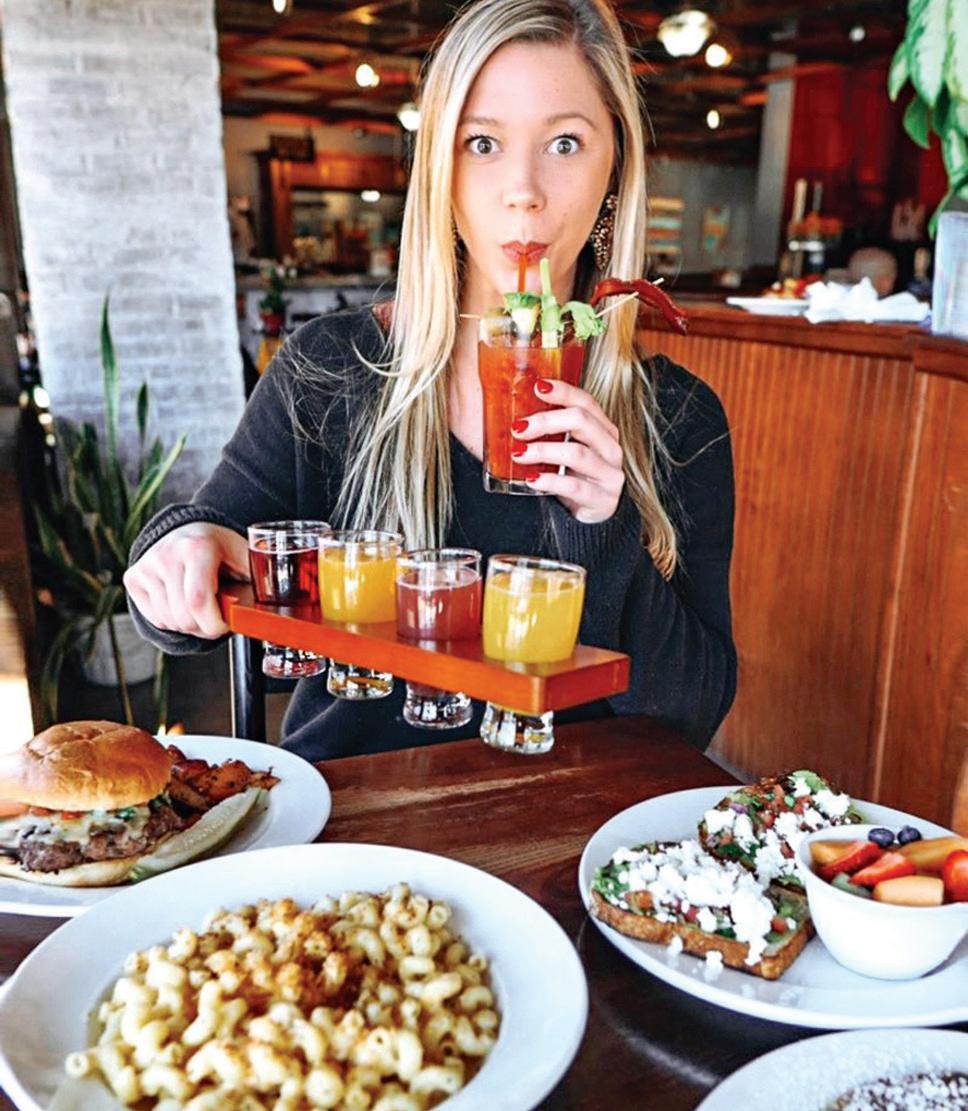


How did your Famous Toastery career journey begin?
I wanted to be back in operations, and I really wanted to run my own restaurant. That’s what got me in the business to begin with. I came across a listing for a Famous Toastery franchisee. When I reached out to the VP of ops and asked about that potential, that led to me meeting with (ceo) Robert Maynard and David Burgess, the COO at the time, in September of 2022. He saw my resume and the breadth of my experience in both QSR, retail, polished casual, all facets of the business I’ve been involved in.
I came on in January of 2023 as VP of ops. Since then, the company itself has really made strides. I think the difference is, now the company is being run by operators. The vision of the brand hasn’t changed at all—it’s still simple scratch, an amazing menu.
What spurred the shift from your corporate role into a franchisee?
I was familiar with Blowing Rock and this whole area. That’s what I enjoy, being out-
doors. I wasn’t born in Boone, but I’m a North Carolinian. I’ve been coming to this area since I was a toddler, and I’ve lived all over the country, working in different types of concepts. To me, this is coming home. Also, the operational aspect in a place that I love, it just made sense. To me, this is just the culmination of all [my experiences]—running a restaurant in Boone, North Carolina, and opening Blowing Rock right behind it.
Making that leap, I mean, yeah, it’s a little scary. You don’t have that safety net of corporate, for sure. But remember when I first met Rob, I was looking for my own thing, so that always pre-existed in my mind, was to run my own shop within the four walls, do what I love to do, and make money at it and grow it. I know how to grow the brand. I was a corporate guy and I was going around visiting restaurants—I see how these guys are in control of their own destinies. How well they do is reliant on how well they execute every day. I like that aspect of it. And I definitely plan to grow the concept.
















































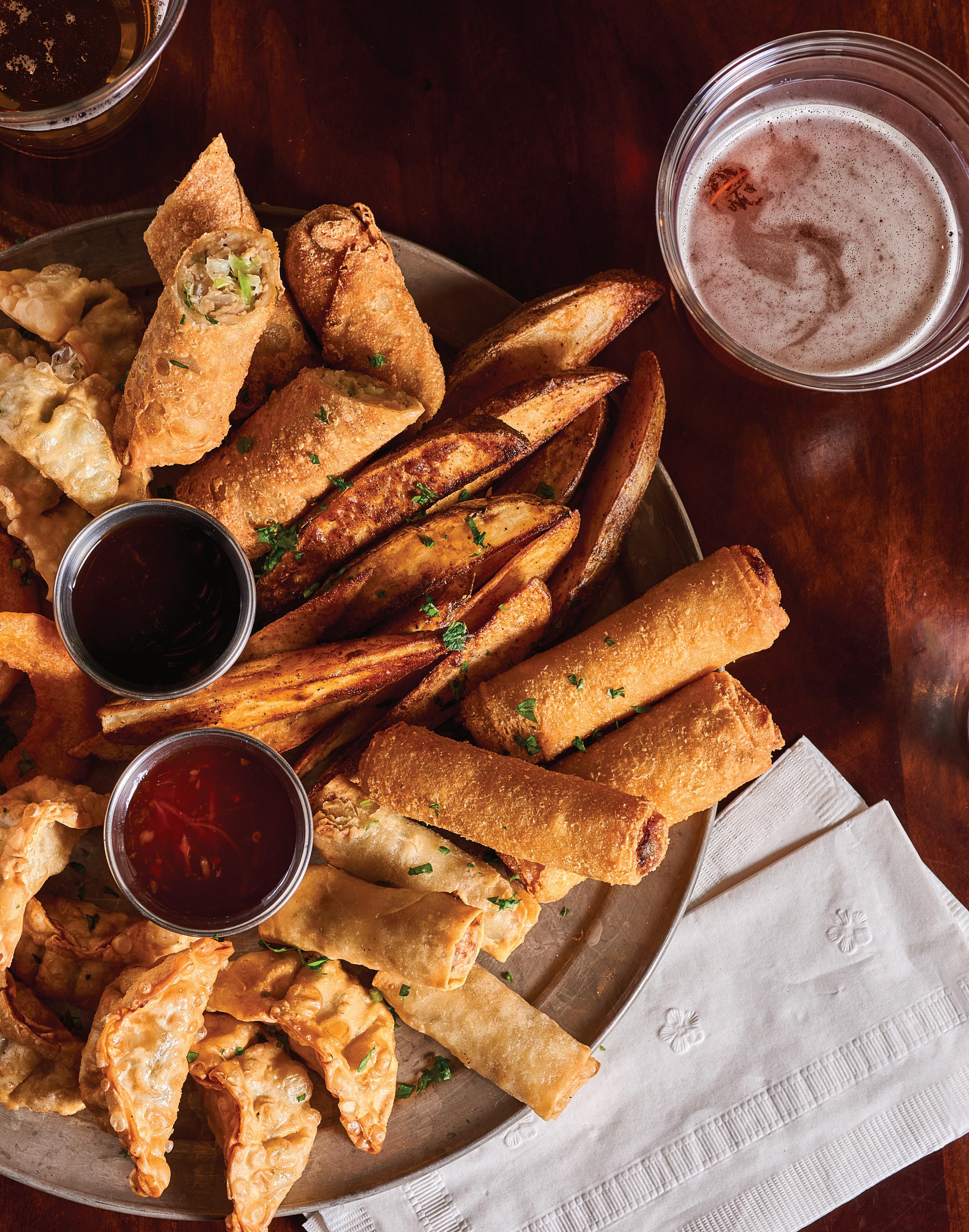
70%* of operators say demand for globally inspired food is increasing. Meet that demand and increase check rings with Asian-Style Appetizers from Schwan’s Food Service.
EGG ROLLS & DUMPLINGS
Easy prep in a variety of flavors.
THE FOUNDATION FOR FUSION
Create innovative applications.
TOP OFF YOUR TOP LINE
More variety means more ways to raise revenue.
Scan here to take your menu to the next level




